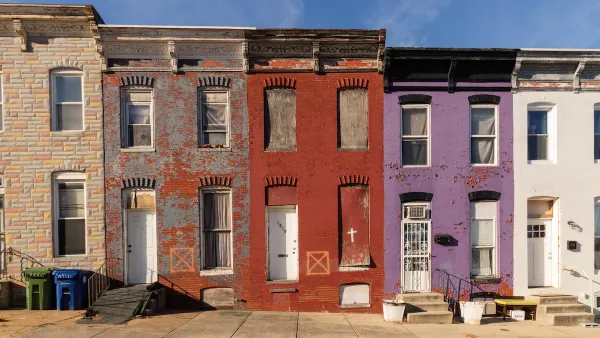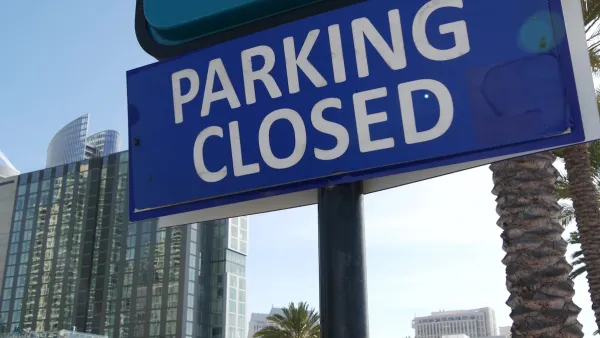Every city has blight – the unsightly, derelict, abandoned, disheveled, and under-utilized spaces of our urban areas. It drains the life out of neighborhoods, drives down the values of surrounding properties, and just looks really bad. So what do cities do about it? Some seize it through eminent domain for redevelopment and others offer incentives to developers to replace it with something better. Many of them, though, don’t do anything at all. But removing blight from a city is not impossible, and it doesn’t have to be an elaborate multi-party scheme or a drawn-out political process. It can be as simple as a coat of paint.
Every city has blight – the unsightly, derelict, abandoned, disheveled, and under-utilized spaces of our urban areas. It drains the life out of neighborhoods, drives down the values of surrounding properties, and just looks really bad. So what do cities do about it? Some seize it through eminent domain for redevelopment and others offer incentives to developers to replace it with something better. Many of them, though, don't do anything at all. But removing blight from a city is not impossible, and it doesn't have to be an elaborate multi-party scheme or a drawn-out political process. It can be as simple as a coat of paint.
In most cases blighted properties are left to rot on their own, below the eyesight of city officials and politicians. But blight out of sight is still blight in the end, and it is a situation that not only feeds on itself, but feeds on its surroundings. Stopping the blight monster from swallowing up entire neighborhoods does require effort, but maybe not as much as some would think.
The borough of Delfshaven in Rotterdam had the very simple idea that if blighted areas were more noticeable they would be more likely to attract the attention of neighbors and the movers and shakers capable of taking the action to remedy them. So they contacted local artist Florentijn Hofman to come up with an idea to make a one blighted and derelict block of the borough more noticeable. Hofman's solution was a new coat of paint – bright sky blue, over the entire building; windows, roofs and all.

The idea was to keep the building in its bright blue state until there was a viable plan to renew or revive the blighted area. And almost instantly, what was once an overlooked and easily ignorable area became one of the most seen places in the city. As Hofman's website describes, "By redecorating this block, which was built in the first years of the 20th century, people start looking again at what was and is there, and maybe think about what they will get in return."

This blue building not only brings people's attention back to a once-forgotten space, but also works to prod the development (or redevelopment) community to take advantage of the existing opportunities in the city. Having a bright blue building screaming at your face every day – whether you're a developer, a planner or a neighbor – would most likely motivate you to see about getting something done.
Other cities should learn from this example, and should start to rethink how they handle (or don't handle) their blighted areas. By creating a situation that is at once a call to action, an unavoidable reminder, and even a tourist attraction, cities can better realize the potential of the blighted spaces they might have otherwise continued to disregard.
UPDATE: Florentijn Hofman recently contacted me to add a little more clarity to this blog post. From Hofman:
"The borough of Delfshaven in Rotterdam asked me to do a wall they wanted to put there to cover the doors of the derelict block. They had the notion of graffiti, and asked me to make a mural with a local graffiti artist. I said 'No!' and came up with this idea. The moral of the story is they wanted to make the area more nice but with an ancient method (graffiti) -- as if that always works. It's a tool they knew. I've given them another tool -- paint the whole block! Now I see it done more and more often in other boroughs of the city."

National Parks Layoffs Will Cause Communities to Lose Billions
Thousands of essential park workers were laid off this week, just before the busy spring break season.

Retro-silient?: America’s First “Eco-burb,” The Woodlands Turns 50
A master-planned community north of Houston offers lessons on green infrastructure and resilient design, but falls short of its founder’s lofty affordability and walkability goals.

Delivering for America Plan Will Downgrade Mail Service in at Least 49.5 Percent of Zip Codes
Republican and Democrat lawmakers criticize the plan for its disproportionate negative impact on rural communities.

Test News Post 1
This is a summary

Test News Headline 46
Test for the image on the front page.

Balancing Bombs and Butterflies: How the National Guard Protects a Rare Species
The National Guard at Fort Indiantown Gap uses GIS technology and land management strategies to balance military training with conservation efforts, ensuring the survival of the rare eastern regal fritillary butterfly.
Urban Design for Planners 1: Software Tools
This six-course series explores essential urban design concepts using open source software and equips planners with the tools they need to participate fully in the urban design process.
Planning for Universal Design
Learn the tools for implementing Universal Design in planning regulations.
EMC Planning Group, Inc.
Planetizen
Planetizen
Mpact (formerly Rail~Volution)
Great Falls Development Authority, Inc.
HUDs Office of Policy Development and Research
NYU Wagner Graduate School of Public Service





























